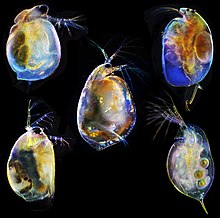| Diplostraca Temporal range: [1]
| |
|---|---|

| |
| Scientific classification | |
| Domain: | Eukaryota |
| Kingdom: | Animalia |
| Phylum: | Arthropoda |
| Class: | Branchiopoda |
| Subclass: | Phyllopoda |
| Superorder: | Diplostraca Latreille, 1829 |
| Orders[2] | |
| |
| Synonyms[2] | |
| |
The Diplostraca or Cladocera, commonly known as water fleas, is a superorder of small, mostly freshwater crustaceans, most of which feed on microscopic chunks of organic matter, though some forms are predatory.[2]
Over 1000 species have been recognised so far, with many more undescribed.[2][3][4][5][6] The oldest fossils of diplostracans date to the Jurassic, though their modern morphology suggests that they originated substantially earlier, during the Paleozoic. Some have also adapted to a life in the ocean, the only members of Branchiopoda to do so, though several anostracans live in hypersaline lakes.[7] Most are 0.2–6.0 mm (0.01–0.24 in) long, with a down-turned head with a single median compound eye, and a carapace covering the apparently unsegmented thorax and abdomen. Most species show cyclical parthenogenesis, where asexual reproduction is occasionally supplemented by sexual reproduction, which produces resting eggs that allow the species to survive harsh conditions and disperse to distant habitats.
- ^ Anderson, Lyall I.; Crighton, William R. B.; Hass, Hagen (December 2003). "A new univalve crustacean from the Early Devonian Rhynie chert hot-spring complex". Transactions of the Royal Society of Edinburgh: Earth Sciences. 94 (4): 355–369. doi:10.1017/S0263593300000742.
- ^ a b c d Cite error: The named reference
WoRMSwas invoked but never defined (see the help page). - ^ Kotov, Alexey (2007). "Jurassic Cladocera (Crustacea, Branchiopoda) with a description of an extinct Mesozoic order". Journal of Natural History. 41 (1–4): 13–37. Bibcode:2007JNatH..41...13K. doi:10.1080/00222930601164445. S2CID 83483722.
- ^ Kotov, Alexey (2009). "New finding of Mesozoic ephippia of the Anomopoda (Crustacea: Cladocera)". Journal of Natural History. 43 (9–10): 523–528. Bibcode:2009JNatH..43..523K. doi:10.1080/00222930802003020. S2CID 84144888.
- ^ Kotov, Alexey; Korovchinsky, Nikolai (2006). "First record of fossil Mesozoic Ctenopoda (Crustacea, Cladocera)". Zoological Journal of the Linnean Society. 146 (2): 269–274. doi:10.1111/j.1096-3642.2006.00204.x.
- ^ Kotov, Alexey; Taylor, Derek (2011). "Mesozoic fossils (>145 Mya) suggest the antiquity of the subgenera of Daphnia and their coevolution with chaoborid predators". BMC Evolutionary Biology. 11 (1): 129. Bibcode:2011BMCEE..11..129K. doi:10.1186/1471-2148-11-129. PMC 3123605. PMID 21595889.
- ^ Vernberg, F. John (2014). Environmental Adaptations. Elsevier Science. pp. 338–. ISBN 978-0-323-16282-1.